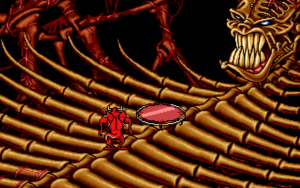On to Wizardry II
As I’ve said before, Wizardry II: Knight of Diamonds would be treated as an expansion rather than a sequel today. You could easily imagine it as DLC. It’s not self-contained — it has no character creation system, so characters have to be imported from Wizardry I. It adds six new dungeon levels, and a whole bunch of new items and monster types (including wereameobas), but operates under exactly the same rules and magic system as the original. Where Wiz1 has a sizeable manual, the documentation for Wiz2 is a single page giving some new lore, a backstory concerning conflicts in the kingdom of Llylgamyn.
This lore is all but irrelevant. All you really need to know about your quest is this: You’re looking for the pieces of a very powerful outfit, and before you claim each piece, you have to subdue it. At the end of level 1, you have a boss fight against a suit of armor, and once you’ve beat it, one of your fighter-types can put it on. It’s extraordinarily good armor, and grants regeneration. Further levels will, if I recall correctly, involve fighting the helm, shield, and so forth. In other words, it’s the same basic idea as Kevin Wilson’s The Underoos That Ate New York!, but taken more seriously. Not entirely seriously, mind. Wizardry has always had a silly streak.
Unlike in Wizardry III, characters aren’t disempowered on import. You lose all your gear, which is a bit of a blow, but you keep all your experience levels and money — which means you can immediately go and buy the very best things available in the shop. Which aren’t the best things available in the game, of course. You can find better stuff in the dungeon. But still, it means my party is reasonably well-equipped and still just as overpowered as when they fought Werdna. So my progress through the dungeon is mainly limited not by the need to grind, but my desire to map the whole thing out. The dungeon levels are a great deal more satisfying than in Wiz1: more intricate and elaborate, and more pleasing to the eye when mapped out. It’s the usual effect in these older series: the first episode is made by people with no level design experience, the second by people with one released game under their belt.
 Comments(0)
Comments(0)